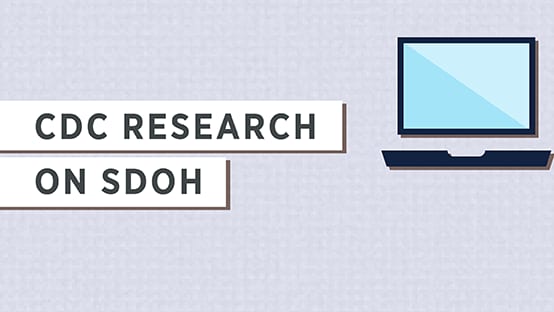Key points
To answer questions related to the CDC research database. Including, how articles were chosen for research selection, what research article topics are included, and how to find them.

How did you select articles for the research section?
We included articles on this website that have at least one CDC author and were published in 2016 or later. This list will be updated periodically to add articles published after this website was developed. We include articles that:
- Focus substantively on SDOH in their underlying research
- Expand the SDOH scientific evidence and knowledge base
- Analyze health outcomes in the context of social and structural factors
- Describe actions that address SDOH to improve health and achieve health equity
Some articles related to SDOH may not have been included because they did not meet these criteria. Examples of excluded articles include:
- Research that primarily describes varying rates of disease in particular populations (e.g., descriptive pieces that do not assign causal connections to social and structural influences)
- Research that mentions social or structural factors in a conclusion but not in the research
- Research focused on mental health or behaviors without explicit linkage to structural or social factors
How can I find research articles on particular SDOH topics?
Articles can be found by keywords using the search function. They are also organized by Healthy People 2030 domains: Economic Stability, Education, Social/Community Context, Health and Health Care, and Neighborhood and Built Environment. There are also articles listed under a general category that do not fit neatly under one of the domains because they discuss cross-cutting topics such as methods, data access, general practices, or other areas unrelated to domains. However, given the nature of social determinants, articles can easily fall under more than one category. For example:
- Articles that largely focus on high levels of incarceration (a social contextual issue) might also discuss challenges in economic stability.
- Articles about the effects of characteristics such as crime levels, which fall under the category of neighborhood and built environment, could also contain content about housing stability. Therefore, such articles could also fall under the economic stability category.
Is research on workplace conditions included in SDOH?
While it is neither a separate domain nor listed as a "key issue" under any of the HP2030 domains, this website has listed research related to workplace conditions under the social and community context domain because:
- Work is a central part of people's lives that affects the physical, psychological, and social well-being of workers and their families.
- Understanding the influence job or career has on health goes beyond the physical, emotional and social hazards, risks, and conditions faced at work.
- A person's job or career also exerts a significant influence over other aspects of life that contribute to or detract from personal health and health of family members. For example, work often determines workers' type of health care, the kind of neighborhood in which they can afford to live, how much money they have to meet their families' needs, and the time they have to spend with their families.
Is research on violence included?
Yes, articles with a focus on violence are included because violence is strongly determined by social and community contextual factors (e.g., limited economic, housing, and educational opportunities; residential segregation; high density of alcohol outlets; systemic inequities; structural racism). These contextual factors can put people at risk for violence or protect them from experiencing or perpetrating violence. Violence research is included under these Healthy People 2030 domains:
- Social and Community Context: Research under this domain helps us better understand the connection between social determinants and the risk of violence such as child abuse and neglect, intimate partner violence, and sexual violence.
- Neighborhood and Built Environment: Research under this domain helps us better understand how structural racism and other forms of oppression in communities can increase inequities in risk for violence, undermining power and trust among community members (e.g., social capital). Reductions in social capital can make it harder for communities to mobilize collective efforts to improve their health. For example, high levels of violence in a community can create conditions in which individuals risk their safety in order to walk or exercise outdoors. In turn, these conditions can also undermine a healthy lifestyle, increasing risk for chronic diseases.
